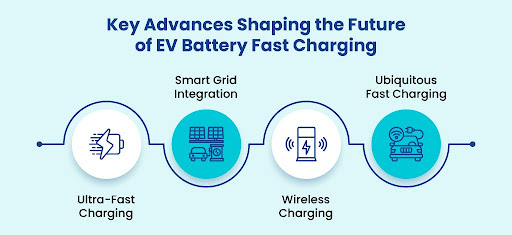Smarter, Faster, and Better: Advances in EV Charging Stations Driving Wider EV Adoption

A convenient and reliable public charging network is critical in accelerated electric vehicle adoption. Rapid innovations in ultra-fast charging, intelligent grid integration, wireless charging, and easy charging access aim to transform this experience.
One of the key challenges still is to help EV owners avoid long waiting times, prevent high electricity bills, and expand the limited charging options. It is safe to say the future of electric mobility hinges on the rapid enhancement of the EV charging landscape.
But what are the latest technologies and innovations making EV charging faster and smarter?
Key Advances Shaping the Future of EV Battery Fast Charging
Here, we explore some of the most promising trends in EV charging technology and how they can improve the EV driving experience for vehicle owners.

1. Ultra-Fast Charging
Recent advances enable dramatic reductions in EV charging times and potential provide range of over 275 kms in under 15 minutes.
The ground-breaking innovations making such powerful charging possible include:
1000V Architecture
Where most current EVs require 30-60 minutes for an 80% charge, new ultra-fast charging systems above 350kW are changing that. As next-generation vehicles employ 800-1000V systems versus the existing 400V platforms, charging rates of over 350kW are possible. This significantly reduces the charging times.
Liquid Cooling
Direct liquid cooling integrated into battery modules helps sustain repeat ultra-fast charging. Dielectric coolant fluids are used to safely remove heat through a closed-loop system, preventing thermal damage.
Silicon Carbide Electronics
By utilizing wide bandgap SiC devices instead of silicon, charger efficiency exceeds 98% at high currents. This enables precise power transfer control and lower heat generation.
2. Smart Grid Integration
In addition to faster charging speeds, advances in EV charging stations include better integration with smart power grids. Intelligent connectivity and coordination between charging networks and utilities can help balance loads and enable vehicle-to-grid (V2G) energy transfer when useful.
V2G Bi-Directional Charging
New charging stations with bi-directional power flow allow EV batteries to provide stored energy back to the electrical grid during periods of peak demand. This helps utilities smooth loads. The advanced power electronics in these chargers also allow for smart charging when energy costs are lowest.
Coordinated Charging
Networked charging stations can intelligently schedule charging sessions across entire fleets of vehicles to optimize overall load profiles. This prevents spikes in demand from large numbers of EVs starting charging simultaneously after typical commute times. Coordinated charging is essential for managing the impact of growing consumer EV adoption on utilities.
Solar Canopies
EV charging hubs are now being designed with integrated solar canopies covering the parking sites. These solar panel structures feed renewable energy directly into the stations, reducing grid dependence. Solar canopies also provide shade and protection from weather for charging vehicles.
3. Wireless Charging
Cutting the cord is the ultimate vision for EV charging convenience. New wireless charging systems can automatically transfer charge between stations and vehicles through magnetic resonance coupling.
Magnetic Resonance Coupling
Wireless chargers use magnetic field resonance between charging pads and receiver coils mounted on the vehicle to safely and efficiently transmit electricity. Similar to wireless phone chargers, the magnetic fields penetrate the air gap without arcs or sparks.
Laser-guided Positioning
Maintaining precise, consistent alignment between the charging pad and vehicle receiver is critical for maximum power transfer and efficiency. Wireless charging stations now incorporate advanced optical guidance systems using lasers, cameras, and image processing to dynamically guide and center the vehicle as it parks over the pad.
In-motion Charging
Taking wireless charging to the next level, companies have demonstrated extended charging pads capable of transferring charge to a vehicle while it is driving. Also termed “dynamic charging”, carefully designed magnetic fields coupled with automatic steering correction allow the continuous on-the-go power transfer to future electrified roadways. This capability can significantly reduce vehicle battery capacity requirements.
4. Ubiquitous Fast Charging
While charging speed has increased dramatically, charging station access and convenience lag behind. Expanding public EV infrastructure requires more creative and scalable solutions.
Ultra-compact Stations
Innovators are packing ultra-fast charging technology into compact, portable stations that can be installed, almost anywhere. Fold-up curbside or lamp post mounted chargers, powered charging plates integrated into parking spaces, and dual-use EV charging parking meters are rolling out to high-demand urban areas. These hyper-distributed stations provide convenient charging access.
Drone Infrastructure Inspection
Fleets of automated drones with imaging sensors are now used to map cities and identify locations in need of new charging stations. Machine learning algorithms analyze the charge demand based on traffic patterns and current station usage. The drones then validate the construction of new optimal sites. This technology enables data-driven, just-in-time infrastructure deployment.
Modular Scalable Stations
Customizable modular station designs allow operators to respond quickly to shifting charging demand.
Standardized power and battery blocks can be snapped together in different configurations as needs change over time. Also, swappable modules enable flexibility and customization from a library of charging elements.
Conclusion
Ongoing improvements in charging speed, access, and integration are eliminating EV recharging barriers, bringing sustainable electric mobility into the mainstream. With ultra-fast thousand-kilowatt charging slashing wait times and new modular designs expanding neighborhood access, "filling up" your EV is nearing the convenience of ‘gassing up’.
Parallel advancements in vehicle-to-grid integration, renewable charging canopies, and automated infrastructure mapping further streamline adoption. As charging inconvenience fades, more consumers can embrace an all-electric, plugged-in future. The EV revolution hinges on charging advancements accelerating sustainable transportation.